Renaissance period
By Cecilia Spicer 8A

The renaissance man
The Renaissance Man which was also called the Universal Man or the Italian Uomo Universale. An idea that was developed during the Renaissance in Italy from an expression by Leon Battista Alberti "that a man can do all things if he will." This quotes embodies renaissance humanism. This is the idea that humanism had a never-ending ability to develop. This led to the idea that all men should try their best to develop their abilities to their full capacity try to absorb knowledge wherever they go.
People in the Renaissance era valued the military and the art of war. They believed that being a soldier showed courage as well as confidence. This helped them to come up with strategies to solve hard situations. They were great patrons who were interested and knowledgeable in the arts, education and literature. However, the Renaissance man always put his morals and values first. This helped them greatly when making important decisions.
A Renaissance man should be very well educated. For example, they should be able to comfortably talk about mathematics as if they are discussing philosophy or sociology. Many of the people that we think of as Renaissance men, didn't rely on a structured education system. In fact, although there were many universities to attend in the Renaissance era, these did not offer studies in these areas. So most Renaissance men were self-taught.
A Renaissance man would often come up with ideas that were controversial, because they questioned the authority and power that came from the Church. Others who created artworks found that this went against the traditions or beliefs of the Church. They came up with revolutionary solutions to the problems of their time and were bold in promoting their ideas to their friends and colleagues.
who is federico da montefeltro?
Federico was born in Castello di Petroia in Gubbio as the illegitimate son of Guidantonio da Montefeltro, lord of Urbino and Duke of Spoleto. Two years after, he was legitimized by Pope Martin V who was the head of the Catholic Church at that time. Federico was legitimized was done with the consent of Guidantonio's wife, Caterina Colonna, who was at the time Martin's niece.
In the aftermath of the Peace of Ferrara in 1433, he lived in Mantua and Venice as a hostage. In 1437, just four years later he was knighted by Emperor Sigismund. In that same year, he was wed to Gentile Brancaleoni in Gubbio. At sixteen, he began a career as condottiero which was an Italian captain in command of a mercenary company. When his half-brother Oddatonio da Montefeltro was assassinated in 1444 in a conspiracy. Federico, whose probable participation in the conspiracy has never been confirmed, subsequently seized the City of Urbino and then became the Duke of Urbino.
Federico is seen as one of the most iconic Renaissance man. He was admired for making decisions based on moral values. He was the owner of one of the most famous libraries in Europe which was also known as Federico's 'studiolo.' His library is seen as on one of the most important landmarks of the Renaissance.
He holds the distinction of having the first rhinoplasty. He had to cut out the upper part of the bridge of his nose, so as to enable him to see clearer in his left eye. This all happened in 1450, when Federico lost his right eye in a tournament. This is said to be the first and the most iconic 'nose jobs' ever completed.
One of the most important and celebrated portraits of the Renaissance era. This diptych shows the Duke of Urbino Federico Da Montefeltro and his second wife Battista Sforza. This diptych was typical of the fourteenth century. It was inspired by the design of ancient coins and silverware, by the two figures are shown in a profile angle. This angle that ensured a faithful representation and a good likeness of facial details even if it didn't show their emotions or sentiments towards each other. In fact, they were deeply in love at this time.
The couple are facing each other and the spatial element of the painting is suggested by the light and the space of the rolling landscape in the background that connects the two pieces. Indeed the background represented the marches over which they ruled.
The chromatic contrast between the bronze skin tones used for the Duke and the brighter pale tones of Battista is striking; her pallor not only respects the aesthetic traditions, which were fashionable during the Renaissance but could also allude to her untimely death in 1472.
On the back of the panels, the Duke and Duchess are featured being carried triumphantly on ancient wagons, accompanied by symbols of Christian virtues. The Latin inscriptions on the back of the frame pay tribute to the couple's moral values. The presence of the images on the reverse side show that the two paintings, was originally a diptych although they are now separated by modern frames.
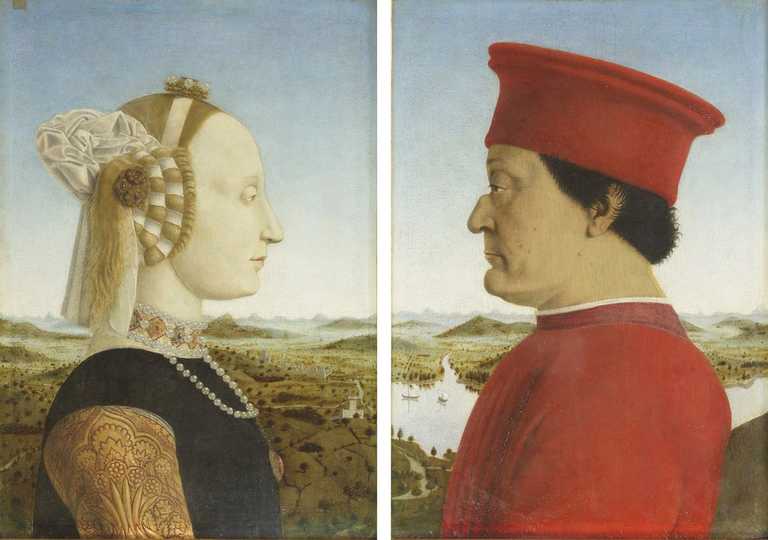
Diptych of Federico da Montefeltro and Battista Sforza
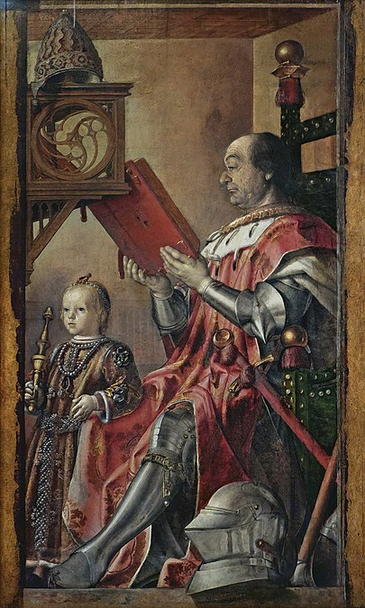
Portrait of Federico Da Montefeltro with his son
Federico is seen as a renaissance man because of his love of art and literature.
An interest in Classical literature was a central theme of being a humanist in the Renaissance. His love of literature is shown by Federico employing over 30 scribes to copy manuscripts from all over the world.
During his lifetime Federico's birthplace became the center of the finest Renaissance art and literature. It's large reputation was mainly due to Duke Federico de Montefeltro, he was seen as the perfect prince. His family had ruled over Urbino since the 12th century. He converted the castle into a beautiful palace and his court, if less glamorous than Florence or Ferrara, was intellectually just as lively.
Federico was known for his strategic methods when he fought in many battles during his lifetime. Often in Italy, an army would try to bribe the other side to be their allies, but Federico refused to be bribed, no matter the amount. He strongly believed in his honor and that was worth more than all the gold in the world. However, he often resolved battles by sending a signed contract to avoid having to fight with them. This is also resulted in Federico getting very rich.
Federico treated everyone equally no matter their class, rank or family. He would compensate families who lost their loved ones after war and he helped those who were wounded from battle. As the ruler and prince, Federico led Urbino as a very inclusive ruler. Each day he would walk around town unarmed to see merchants and townspeople. He'd ask how he could improve Urbino. He always listened to people's problems and tried to solve them as a true Renaissance man. He was a very strong believer in the new idea of humanism, and believed in making choices that benefited almost everyone, with equal treatment.
Fedreico da monteletro's Studiolo
What is a studiolo?
A studiolo is a small painted barrel vaulted room. It was most well known for coming from Palazzo Vecchio, Florence, Italy. It was first commissioned by Francesco de'l Medici, Grand Duke of Tuscany. It was finished for the Duke in 1570. It was completed by the artists who were under the supervision of Giorgi Vasari and the scholars Vincenzo Borghini and Giovanni Batista Adriani.
What is in a studiolo?
A studiolo contained books, artistic depictions for example paintings. The paintings that were in a studiolo represented mythologic or religious figures. Many of the paintings were by Florentine painters. It didn't represent their best effort, but the high point of Florentine Mannerism. The studiolo also consisted of scientific instruments and other symbols of knowledge.
What is the reason for a studiolo?
Many nobles used their studiolo for leisure pursuits, studying, writing and for correspondence. It was also used for displaying and studying the highlights of their collections. Many of which were usually archaeological items, moving to compare modern artworks with ancient artworks. They would write poems that would describe paintings. It was an art form in itself.
The pseudo allegiance to science had the sense to illustrate and dominate the education of future monarchs. There was also the slight hint toward the encyclopedic philosophy of the Enlightenment.
The reason why Federico Da Montefeltro loved his studiolo so much was because a studiolo was a place of culture, art and study. Federico was interested in these things the most. It is assumed that he spent the majority of his day in his studiolo. He appreciated art and culture so much that he was an avid patron.

A wall of paintings in a studiolo
My Studiolo
I look up to Jean Rondeau who is a world renowned French harpsichordist and pianist. He was taught by Blandine Verlet who was internationally known for her recordings of Francois Couperin. He studied at the famous Conservatoire National Supérieur de Musique in Paris. Since I am currently studying the harpsichord he is an avid inspiration to me. When I am playing and when I am not.
I look up to my sister because she has always been there for me and she has always set a good example for me to follow. I feel safe whenever I am with her and she is my idol. She had been with me through thick and thin, if I get hurt or sad she is my number one person to go to. No matter if she has annoyed me in some way I will always love her.
I look up to Scott Ross because he brought the harpsichord back from the museum to the concert hall. He also recorded all 555 harpsichord sonatas of Domenico Scarlatti all by himself when he was very ill. He also taught many of the greatest harpsichordists. He was able to understand how Renaissance art, architecture and poetry connected to music of this time. Since I hope to study music in the future I hope I can become like him in the future.
What do they represent?
Jean Rondeau would be in the form of either a harpsichord and a clavichord. He would represent all music in my studiolo. He would represent everything that would be played and how it would be played.
My sister would represent all the books and literature in the studiolo. Everything that would be read or studied in the studiolo. Everything that is learnt from these texts and everything that is going to be learnt. In this way, she is an example of how you can be a self-taught expert.
Jean Rondeau won't be the only one who would represent music. Scott Ross would represent all the sheet music in the studiolo and the way the studiolo is built (architecture). This is because Scott Ross appreciated the architecture from each era. He draws from what was built during the time and puts this into his playing.
Are the people I look up to renaissance men and women?
Since being a Renaissance man means being emersed in the arts and literature, Jean Rondeau is a Renaissance Man. He is quite knowledgeable in music and art especially of the Renaissance and Baroque Era.
My sister as knowledgble as she is I believe that she is not a Renaissance woman. She is not a musician and she isn't very knowledagble in the arts. Altough she has an avid love for literature and reading.
Scott Ross is a Renaissance man because he admired art architecture and poetry from the Baroque and Renaissance era and moved that into his playing. You can hear it all over his music and the interpretation of that time being shown.
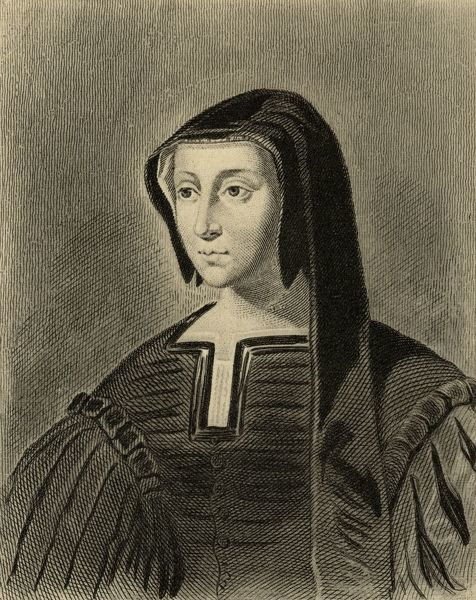
louis of savoy
Louis of Savoy (11 September 1476 – 22 September 1531) was a French regent and noble, the 'Duchess suo jure' (a latin phrase meaning in her own right) of Auvergne and Bourbon, she was Duchess of Nemours and the mother of King Francis l. She served as the regent of France in 1515, 1525-1526 and in 1529 also while being politically active.
The death of her husband and her husband's cousin (the king of her time) made her son Francis the King of France. On February 1525, Louis was named Duchess of Angoulême, and on 15 April 1524, Duchess of Anjou.
She was the principal negotiator for the Treaty between the Holy Roman Empire and France which concluded on 3 August 1529. That's why this treaty was later called "the Ladies' Peace". This treaty put a end to the second Italian war between the Habsburg dynasty, Charles V, Holy Roman Emperor and Francis l.
Why was louis of savoy a renaissance woman?
Louis of Savoy was a Renaissance woman and humanist. She educated her daughter in not only embroidery but academic subjects that were not normally taught to women. Louise was an avid political figure. She stood apart from the other females of her time because of her independence. Her loud voice that spoke in and out of the court. When she became regent she became regent suo jure in her own right meaning she had independence in making decisions that concerned France. Whenever her son was away at war or on a diplomatic trip. She would take over as monarch while he was away.
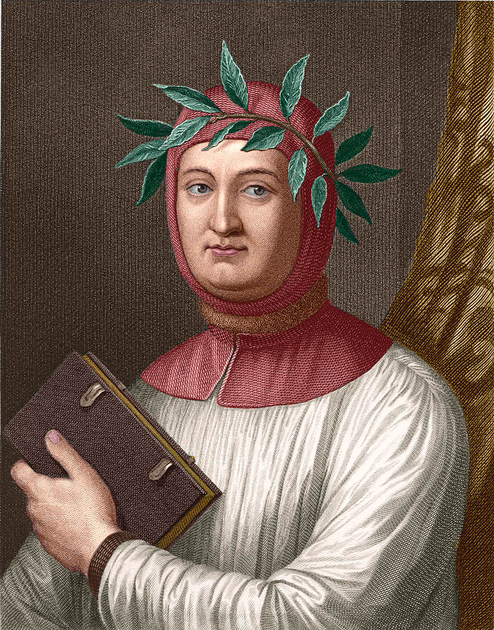
Francesco Petrarca
Francesco Petrarca was an Italian scholar, poet, and humanist. His poems were addressed to his muse Laura. She was his beloved, idealized woman and his poems to her contributed to the flowering lyric poetry of the Renaissance. His curious mind and love of Classic authors led him to go on adventures and to travel. He visited men who loved to learn. He searched monastic libraries for Classical manuscripts. He became forever known as the greatest scholar of his age.
Petrarca was known as a Renaissance man because he was a devoted scholar who was later known as the "Father of Humanism." This philosophy which sparked the Renaissance. Petrarch's writing shows odes to Laura and his writing was used to shape the modern Italian language.
Petrarch was born as Francesco Petrarca in 1304, in a Tuscan town in Arezzo. His father had the job of a notary, and Petrarch, as well as his brother, was set on the path of careers in law. Petrarch studied law in Bologna and Montpellier, but despite his beautiful and brilliant mind, he had no passion for law. Being a lawyer was simply boring and he saw the legal profession as basically selling people out.
Petrarch's true passions were reading Latin literature and writing poetry. He continued to study law but he started to write poetry. It is worth noting though that this is the same decade as to when Dante Alighieri's Divine Comedy was published. This certainly had an influence on Petrarch's future works.

Petrarch was passionate about studying ancient literature and writing poetry
In 1326, Petrarch moved to Avignon in the south of France to start working as a legal clerk. This profession gave him time and freedom to pursue his writing. He would spend much of his life traveling between Italy and France, writing in both regions.
In this same decade he met a woman named Laura and fell in love with her. Although she was married and spurned his advances. He then turned to his poetry and compiled a 336 lyric poem book, in the vernacular language (everyday speech).
These poems were compiled in a collection called the Canzoniere (songbook). Not only did this work become so influential that it was credited with helping to built the modern Italian language. It also cemented a new poetic form of the sonnet.

Petrarch and Laura in the Renaissance, a topic that many Renaissance artists grew to obsess over
"Rarely do great beauty and great virtue dwell together."
Petracha
Religion and the Church
In the Renaissance the massive focus around Religion had faded from the middle ages and a new idea had formed called humanism. It was praised for removing medieval superstitions and elevating self to freedom over traditional religious authorities. But the most defined feature of the Renaissance is the recovery of biblical concepts of human dignity and how that helped pave the way to artist, social and intellectual minds.
The great minds who emerged during this period, some benefitting from the patronage of the Medici family, saw no problem with the world and pursuing God. Copernicus, Kepler, Newton, Galileo: each of them agreed that "the book of nature" was "written by the hand of God in the language of mathematics." Against their critics, they saw an important breakthrough with contributing to a sacred mission. Newton once explained that his Principia (1687) had an apologetic purpose: "When I wrote my treatise about our system I had an eye upon such Principles as might work with considering men for the belief of a Deity, and nothing can rejoice me more than to find it useful for that purpose."

Renassiance vs today
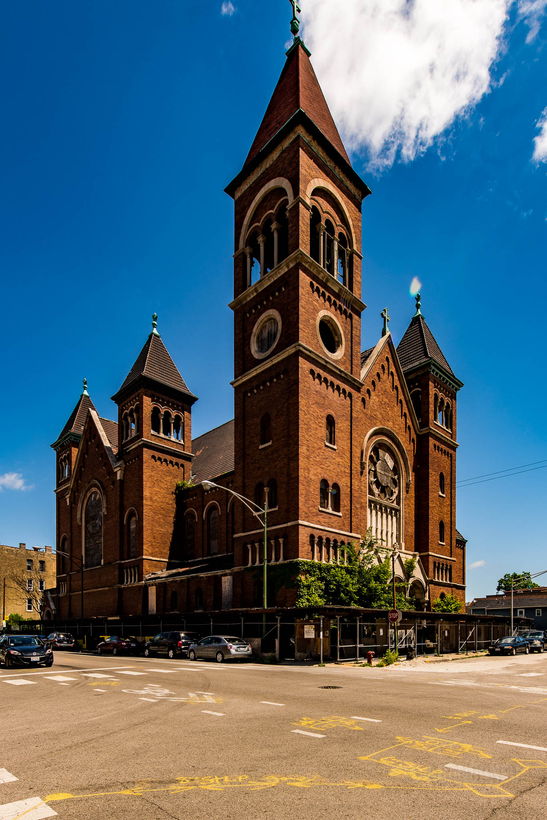
In today's society we can see similarities to how traditional religious beliefs have a reduced importance compared with people's personal views. This is due, in part to the respect for different beliefs and their cultural opinions and appearance. But this wasn't always the case, in the Medieval Catholicism was the main belief mainly associated with power and the monarchy. Then humanism came and changed the way people think. Classical religious practices nowadays have been marginalized with new ways of experiencing religion and spiritually. These ways are emerging in a less committed way and a questioning or more individual way.
Renaissance Vs Today

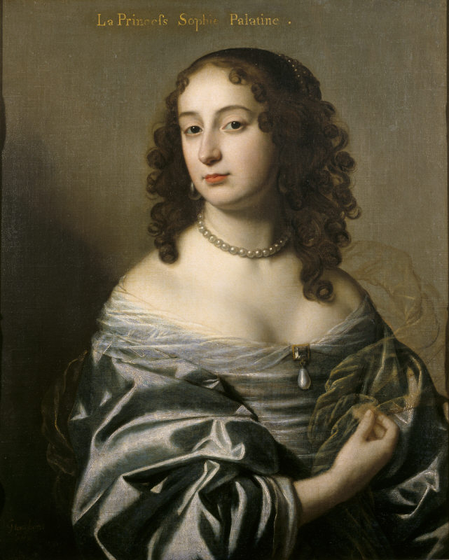
Clothing
High fashion was popular for both women and men in the Renaissance era. It reached a high especially in the 15th century, with the jewel-encrusted fabrics of astonishing richness, and the colors to rival but math the feathers of tropical birds. In fashion, Italy was leading the crowd, through the popular trend of slashing garments that had contrast of color through the streaks or breaks in the material of the clothing, this strange trend was surprisingly started among Swiss soldiers.
Women's costume exposed a lot of bosom but nothing else: skirts remained at floor length. Different governments had different laws and each passed sumptuary laws, which forbid people below a certain rank to wear certain clothes. The result of this was... the laws were generally ignored.
Changes to fashion can be attributed to technological changes, in the development and the growth of new fabrics and ways of finishing fabrics and treatments contributing to more sophisticated outcomes. Modern day fashion has changed in appearance, but still reflects aspects of the current culture. Back in the Renaissance era, women had to wear uncomfortable clothing that included heavy jewels, small shoes, corsets. This is also included the unneeded but very popular trend of plucking ones forehead to show beauty.
Today, people are free to wear whatever they want. In most countries now, they don't have restrictions and rules of what people can or can't wear. Everybody is allowed to express their own style and nurture their creativity through fashion. Women still wear uncomfortable clothing for example, corset like tops, extravagant gowns, high heels and heavy jewels.
Women's Independence and rights
In noble families and some wealthy middle class families, girls as well as boys were often taught by a private tutor. Girl's schools for the well-off merchant class were run by nuns. But in general, the education of women was not taken seriously. The schooling was often interrupted by early marriage (a far more important matter at the time). As for the lower classes, education was regarded as pointless. These girls needed only to learn the skills of housekeeping, from their mothers. However, due largely to the availability of printed books. More women were educated in the 16th century than earlier times.
In most regions of Europe, when a woman of the upper class got married. She was expected to bring her new husband's household a portion of her father's wealth. This was called a dowry, which was money that was usually used as a claim on her inheritance. The function of the dowry was to remove a woman from her father's line. So that she had no further claim on his property. (This dowry was usually of small size)
Women also had no choice in who they were allowed to marry. So love was usually out of the question. That choice was usually left to the father or the eldest brother.

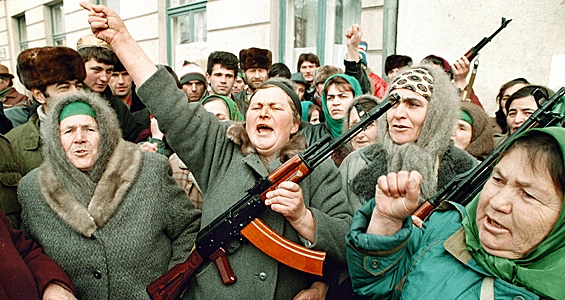
Renassiance vs today
Women now have many more opportunities for employment in Australia. Women are allowed to learn and academically women are no longer frowned upon. There's less distinction between social classes now and women are starting to rise in jobs that were once only done by men, although parliament and other trade jobs are mainly male dominated. Even so, women now have the right to vote and are now considered a very important part of society.
Women no longer are bargained for marriage between fathers and prestigious households. There is no longer need for the vocabulary of dowry since we no longer are auctioning daughters off to marry. Women are now allowed to choose who they want to marry and how.
Women are no allowed to own a single property and they are allowed to hold the rights to property.
MY BIBLIOGRAPHY
https://en.wikipedia.org/wiki/Diptych_of_Federico_da_Montefeltro_and_Battista_Sforza (Accessed on the 1/06/2022)
https://www.britannica.com/biography/Petrarch
(Accessed on the 1/06/2022)
https://en.wikipedia.org/wiki/Federico_da_Montefeltro
(Accessed on the 1/06/2022)
https://www.encyclopedia.com/history/encyclopedias-almanacs-transcripts-and-maps/women-renaissance-and-reformation
(Accessed on the 3/06/2022)
www.biography.com/scholar/petrarch
(Accessed on the 3/06/2022)
https://www.washingtonexaminer.com/weekly-standard/religion-and-the-renaissance
(Accessed on the 3/06/2022)
https://journalnow.net/the-role-of-religion-in-todays-society/
(Accessed on the 5/06/2022)
https://fashionz.co.nz/how-and-why-has-fashion-changed-over-the-last-50-years
(Accessed on the 5/06/2022)
https://www.britannica.com/biography/Federico-da-Montefeltro
(Accessed on the 1/06/2022)
www.cram.com
(Accessed on the 1/06/2022)
https://classroom.synonym.com/can-women-now-could-not-1800s-21019.html
(Accessed on the 3/06/2022)
https://www.thoughtco.com/what-are-womens-rights-3529028
(Accessed on the 3/06/2022)